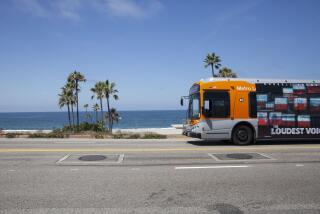Modest Proposal : Gump’s ‘Simple, Noble’ Bus Stop
- Share via
PAUL CASEY
Los Angeles resident, student at University of Chicago
“Forrest Gump” appeals to us because it shows that a simple life defined by severe limitations can be led with great dignity. We see him go many places, even make lots of money. But the one thing we never see him do is drive: He exemplifies the millions of Americans who, for one reason or another, depend on other means to get around.
Maintaining one’s sense of dignity while waiting for the bus is an integral part of the transit experience. Gump seated, waiting, does not have to place his feet on the edge of the gutter. His knees are not inches from speeding vehicles. The pedestrian space has not been whittled away for turning lanes and “improved traffic flow.”
Even the bus stop itself ennobles his character. The bench is simple, without artifice; one plank for the seat and three for the back. Monumental shade trees provide a pleasant backdrop. The bus stop is elevated, slightly but distinctly, on a brick platform surrounded by a clean white border. The subliminal message is very clear: This space is special. It is for people who ride the bus and they have status.
But on the streets of Los Angeles, the picture is quite different. Passengers often wait curbside, close to the fragrant fumes of passing traffic, with no place to rest out of the sun or rain. One of the few exceptions is West Hollywood, which has interesting looking, brightly colored, comfortable bus benches, complete with arm rests. These benches suggest that people who exercise a sense of taste in their daily lives can also ride the bus.
Maybe it is time for Hollywood creative types to do for Los Angeles transit what they did for Georgia in Gump: Send in the set designers.
There is the successful precedent of Metrolink, the commuter train service which held a design competition for their color scheme and logo. The attractive, periwinkle blue and white trains with the distinctive logo were designed by an art student for a cash prize of $1,000.
And what about those shrill toots that Red Line trains make as they enter each station? A competition among the many sound-effects wizards in town would certainly produce a warning sound that was effective, pleasing, even entertaining, and distinctly identifiable by world travelers as belonging to the Los Angeles Metro.
It’s a chance for Hollywood to have more than a fleeting role in the lives of real-life Forrest Gumps whose dramas unfold on public transit every day.
More to Read
Sign up for Essential California
The most important California stories and recommendations in your inbox every morning.
You may occasionally receive promotional content from the Los Angeles Times.













